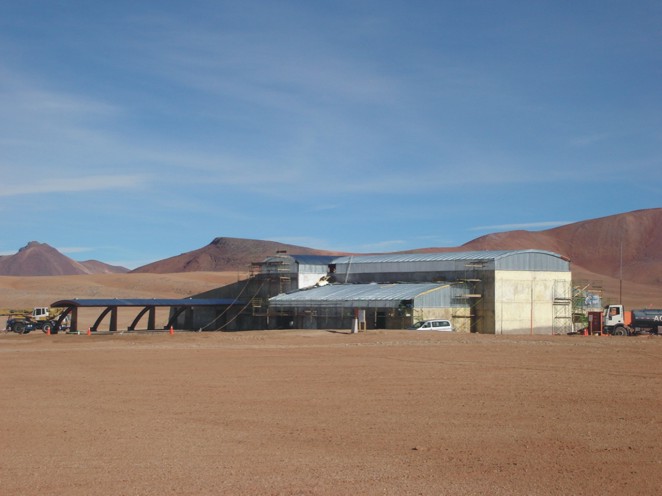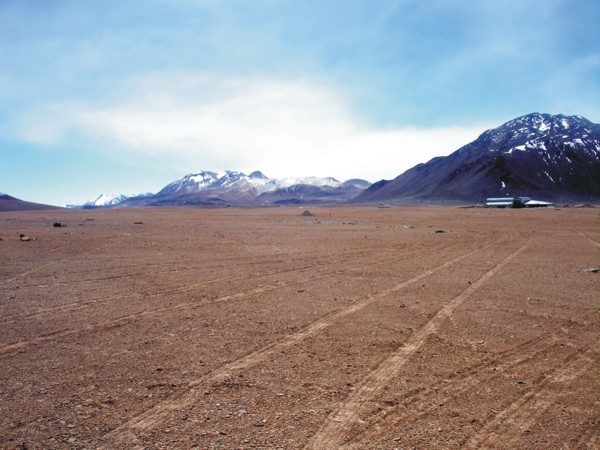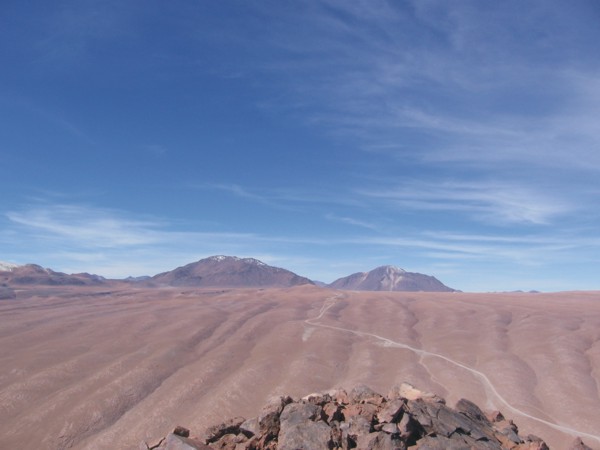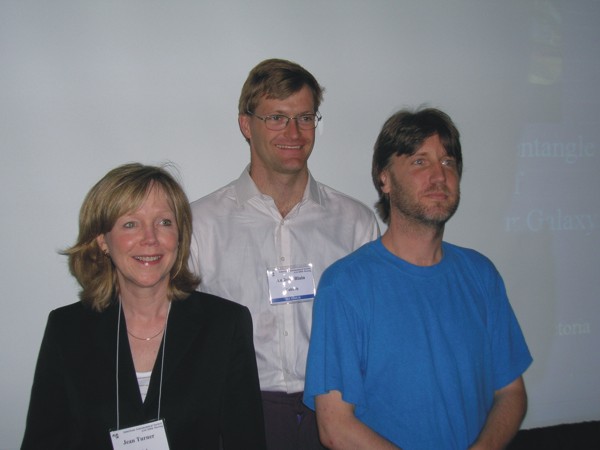ALMA NRAO News July 2006
ALMA News from the July 2006 Issue of the NRAO Newsletter
ATACAMA LARGE MILLIMETER ARRAY
ALMA Construction

Figure 1. The Array Operations Site (AOS) Technical Building (TB) exterior, which will house array electronics such as the ALMA Correlator, has been completed. It is one of the highest-altitude (16,570 feet), highest-technology buildings in the world.
From Chile to Socorro and Charlottesville ALMA has progressed handily in many aspects over the past quarter.
In Chile, the outer shell of the Technical Building (TB) at the Array Operations Site (AOS) on the Chajnantor plain has been completed, and on June 1 a contract was signed with ConPax in Santiago to finish the interior during the current austral winter through summer period. By the end of next March we should be able to see the completed AOS TB sitting at 5000m (16,570 ft) on the Chajnantor plateau, arguably the highest building in Chile and among the highest anywhere.
Elsewhere on the Chajnantor plain, planning for the network of roads and fiber interconnecting the AOS TB and the antenna pads is underway. A few dozen kilometers down the road connecting the high site to the rest of the world, the construction of the Operations Support Facility (OSF) will soon commence. Located at a more pleasant 9600 foot altitude, this large facility will house the rest of the array electronics including the local archive, as well as the people who work to make ALMA produce transformational science around the clock. Here, facilities exist for the temporary housing of ALMA and contractor personnel. Construction

Figure 2. The AOS TB as seen from the future center of the array. As construction progresses, this area will contain the antenna pads for the compact configuration of ALMA.
of the on-site antenna erection facilities continues in preparation for the arrival of the first production antennas on the site in less than a year.
In Santiago at the Joint ALMA Office, several new hires have joined the ALMA team. Christian Saldias has begun work as the new IT Manager. He will soon be joined by a Human Resources manager. Additionally, in preparation for the operation of the Joint ALMA Observatory, advertisements have been placed for key personnel including the Head of Science Operations, the Head of Administration, and the Head of Technical Services. During the past few months the European Project Scientist, Tom Wilson, has acted as JAO Project Scientist; in June the Japanese Project Scientist, Ryohei Kawabe assumed that post. Al Wootten, the North American Project Scientist, will relieve him in September. Shortly afterward, a permanent JAO Project Scientist should assume the role. As the number of people increase, the details of the permanent headquarters for the Joint ALMA Observatory are being defined. This headquarters will be located in the Vitacura section of Santiago, near ESO's facility.

Figure 3. In this photo from the 5000m altitude Cerro Negro by C. Ocampo, the road which will carry the antennas to the AOS TB can be seen in the foreground. The AOS TB itself is in the distance, to the right of Cerro Chascon (rightmost distant peak).
In North America, the assembly and integration of the ALMA Prototype System is entering its final laboratory phases before moving to the prototype antennas at the Antenna Test Facility (ATF) near the VLA on the Plains of San Augustin. In the lab, recent successful tests of the whole system included the demonstration of the first millimeter wave cross-correlation, at 86 GHz. The holography system that will be used in Chile to test the first production antennas will be assembled, integrated, and verified at the ATF in September and October before being shipped to Chile for installation at the OSF. Work on the VertexRSI production antenna proceeds, with initial shipments to Chile expected around the turn of the year. In March, Computing conducted an end to end (scheduling block to archive) test of the optical pointing commissioning observing mode, the first time the entire end-to-end software system worked together on real hardware (antenna evaluation used a small subset of the computing subsystems). In May, Computing conducted its fourth incremental Critical Design Review (internal to Computing this time), including the first reviews of the ACA software subsystem and the Observatory Operations Support software, which have recently ended their first design phase.
At the NRAO Technology Center in Charlottesville, work continues on several fronts. Over the past few months, the Front End Integration Center, one of two facilities in which the receiver and associated electronics will be integrated, has taken shape. A preproduction
1.3 mm (ALMABand 6) receiver has been proven on the sky at the University of Arizona Submillimeter Telescope on Mt. Graham. The first of the 3 mm (ALMA Band 3) receivers will soon be shipped from the Herzberg Institute for Astrophysics in Victoria, Canada for integration as the first front end package is readied for deployment at the ATF in less than a year. The second quadrant of the correlator is taking shape next to the first quadrant, which has been assembled and running for several months now.
Several astronomical meetings during the period highlighted ALMA instrumentation and science. About one hundred young astronomers and astrochemists met at Fulgso, Denmark near the University of Aarhus for a meeting on Complex Molecules in Space: Present Status and Prospects with ALMA, organized by David Field. The synergy of ALMA's transformational science with NASA's Great Observatories program was discussed by Chris Carilli, the new Head of the North American ALMA Science Center, at a workshop in Pasadena. Al Wootten represented ALMA at a workshop on the Red Rectangle held at the University of Virginia. Several aspects of ALMA instrumentation were presented at the SPIE meeting on Astronomical Telescopes and Instrumentation held in Orlando. There were special ALMA sessions at the joint American Astronomical Society/Astronomical Society of Canada meeting in Calgary during June. During the upcoming months, there will be several venues at the IAU meeting in Prague looking forward to ALMA science. During October there will be a meeting on Water Vapor Radiometry in Bavaria. An international meeting on Science with ALMA: A New Era for Astrophysics will be held November 13 - 16, 2006 in Madrid, Spain.
By July, ALMA integration will have moved to the ALMA Test Facility near the VLA, leading within a few months afterward to the first interferometry using ALMA hardware. At about the same time, the first production antennas will begin to arrive at the ALMA site in Chile. The months just ahead begin the period of ALMA field assembly integration and verification leading into commissioning and the early days of delivery of ALMA's transformational science.
Al Wootten
North American ALMA Science Center (NAASC)
This has been a busy quarter at the NAASC. NAASC and other NRAO staff were involved in a test of the ALMA pipeline system in early April. A preliminary version of the NA ALMA operations plan was reviewed internally at NRAO on April 11 by representatives from Green Bank Operations, New Mexico Operations, the End-to-End project, the EVLA, Fiscal, HR, the Director's Office, and NRC. The plan was well received, and the committee's recommendations are being implemented. The plan was then presented to the NRAO Visitors Committee (April 18), the NSF (April 24), and the Users Committee (May 18). In May, the JAO Director, Massimo Tarenghi, visited Charlottesville to work on the ALMA Operations Plan. Trips are planned to Chile and ESO in the coming months to continue this work. Finally, the NAASC sponsored a special session at the June meeting of the American Astronomical Society (see accompanying article). More information on the NAASC is available at www.cv.nrao.edu/naasc/.
The ALMA Regional Center (ARC) is a subset of the NAASC, with the responsibility of providing the core scientific support of the ALMA observatory. There are three ARCs planned: one each in North America, Europe, and Japan. John Hibbard continues in his role as the manager of the North American ARC. Paola Andreani, formerly of SISSA, has relocated to ESO in Garching to head the European ARC; and Kawabe Ryohei of NAOJ heads the East Asian ARC. This quarter the ARC managers are revising the global ALMA Operations Plan, in collaboration with the Joint ALMA Observatory (JAO) director, Massimo Tarenghi, and other JAO staff in Chile.
There have been on-going discussions between NRCHIA and NRAO to discuss the greater North American operations of ALMA. Face-to-face meetings were held in Charlottesville in April and again at the June meeting of the AAS in Calgary, Alberta. Bi-monthly teleconferences and an August face-to-face meeting are planned to continue this productive partnership.
The goal of this summer's activities is to have a complete global and North American ALMA operations plan that capitalizes on the long-standing expertise in interferometric operations at NRAO and best incorporates the Canadian contribution to operations, as well as promotes community involvement in ALMA operations.
J. E. Hibbard and C. L. Carilli
ALMA North American Science Advisory Committee (ANASAC)
The ALMA North American Science Advisory Committee (ANASAC) is composed of representatives of the wider North American astronomical community to provide scientific advice to the NRAO Director on the operation of the NAASC. The ANASAC met via telecon on April 28, 2006. A number of topics were discussed, including the results of the recent ALMA reviews, the current ASAC charges, and a possible grants program to support work demonstrating the ALMA's unique scientific capabilities. The next ANASAC telecon is scheduled for June 30, when future NAASC workshops and the NAASC proposal to NSF will be discussed.
Subsequent to the meeting, Jonathan Williams of Hawaii was appointed as the new ANASAC Chair. Jonathan has been enlisted to organize ANASAC input into key U.S. community issues, such as a potential grants-with-observing-time program, as well as to perform a general review of the North American ALMA operations plan. A listing of the current ANASAC membership and dates of scheduled meetings are given at www.cv.nrao.edu/naasc/admin.shtml. The community is encouraged to contact their ANASAC representatives with any ideas or questions on NA ALMA operations or the Science Center.
Chris Carilli
ALMA Special Session at Calgary AAS Meeting
Members of the NAASC, including our Canadian colleagues, organized a special session at the June meeting of the American Astronomical Society (AAS) entitled Imaging Star Formation in the Cosmos with ALMA. The June 5 afternoon session was filled to capacity, with nearly 200 AAS and Canadian Astronomical Society (CASCA) members in attendance to hear presentations on Using ALMA to Disentangle the Physics of Star Formation in Our Galaxy by Douglas Johnstone (NRC-HIA, U. Victoria), Imaging Star-Forming Gas in Nearby Galaxies with ALMA by Jean Turner (UCLA), and ALMA and Distant Galaxies by Andrew Blain (Caltech).
The special session included an accompanying poster session (#51) Imaging Star Formation in the Cosmos with ALMA II, with nine posters and one in session #56 on the 3mm cartridge. These posters also traveled to the JAO in Santiago the following week. Invited session 30.01 featured Christine Wilson speaking on

Presentors (l-r): Jean Turner, Andrew Blain, and Douglas Johnstone
Luminous Infrared Galaxies with the Submillimeter Array: Probing the Extremes of Star Formation.
Powerpoint and pdf versions of the talks from the special session and several of the posters are collected at http://www.cv.nrao.edu/naasc/TownMeetings/.
J. E. Hibbard and C. L. Brogan




Connect with NRAO